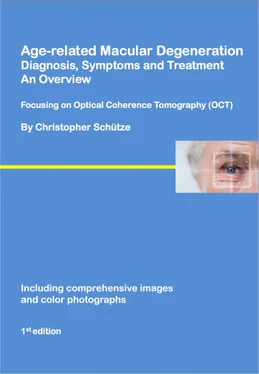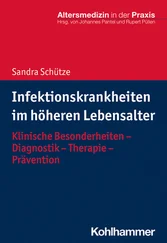Chapter 1 6
Introduction: 6
Chapter 2 8
Optical coherence tomography (OCT) : 8
2.1 Imaging the human retina by OCT in ophthalmology: 8
Chapter 3 10
Basic principles of OCT imaging: 10
3.1 Optical interferometry and time domain OCT: 10
3.2 Low-coherence interferometry: 11
3.3 Spectral or Fourier domain OCT: 12
3.4 Axial and transversal resolution: 12
3.5 Polarization-sensitive OCT: 13
Chapter 4 15
The human eye: 15
4.1 Structure and function of the human retina: 15
4.2 The role of rods and cones: 17
4.3 The retinal pigment epithelium (RPE): 17
4.4 Bruch´s membrane: 18
4.5 Signal processing within the retina: 18
4.6 Retinal blood supply: 18
Chapter 5 19
Age-related macular degeneration (AMD): 19
5.1 Prevalence of AMD: 19
5.2 Risk factors for AMD: 19
5.3 Histopathology of drusen: 20
5.4 Appearance of drusen in fluorescein angiography: 21
5.5 Atrophic/dry AMD: 22
5.5.1 Symptoms: 22
5.5.2 Clinical findings: 23
5.9 Geographic atrophy: 23
5.6 Neovascular AMD: 24
5.6.1 Symptoms: 24
5.6.2 Clinical findings: 24
5.6.3 Angiographic characteristics of neovascular AMD: 26
5.7 Differential diagnoses of neovascular AMD: 28
5.8 Treatment of AMD: 28
Chapter 9 30
Conclusion: 30
References: 31
Curriculum vitae 41
Summary/Précis:
Age-related macular degeneration (AMD) is a chronic disease leading to severe visual deterioration and impairment of daily life. Two types of AMD are distinguished: Wet or neovascular AMD and dry AMD. Dry AMD is characterized by drusen (small yellowish retinal deposits) and atrophy of the retinal pigment epithelium (RPE); causal treatment is currently not available.
Wet AMD is marked by abnormal growth of blood vessels within the macular area (spot of sharpest sight) leading to fluid accumulation (edema) and retinal bleeding as well as scar formation. If the disease is not treated severe irreversible visual impairment will result. Treatment with new agents that are administered intravitreally and act against vascular endothelial growth factor (VEGF) are now available, impeding disease progression in many cases.
The present book gives a comprehensive overview about all aspects of AMD, useful for affected patients and interested readers and covers causes, epidemiological facts, diagnostics (emphasizing the topic optical coherence tomography-OCT) and treatment strategies of the disease, based on extensive literature research.
Imprint:
© 2018 Vienna, Austria, by Christopher Schütze; The present book is based on the doctoral thesis Schütze et al., 2014 found in the list of references.
Introduction 1:
AMD is a disease affecting the macula, the part of the eye responsible for central vision. The disease mainly affects people over 50 years of age. Early and late characteristics of the disorder can be differentiated (Kanski et al., 2008b):
Early characteristics of AMD include discrete yellow deposits in the macular region (drusen), hyperpigmentation of the RPE, and well-circumscribed regions with RPE depigmentation. Late characteristics are presence of regions of circumscribed RPE atrophy (geographic atrophy,-GA) with exposed choroidal vessels in case of dry AMD. Pigment epithelial detachments (PED), or subretinal/sub-RPE neovascularization occurs in case of neovascular AMD (Kanski et al., 2008b).
The diagnosis of AMD disease is made clinically by ophthalmoscopy, fundus autofluorescence imaging (FAF), and fluorescein angiography (FA). Other diagnostic modalities include techniques like optical coherence tomography (OCT). FAF images autofluorescent retinal tissue (particularly metabolic by-products that are not metabolized adequately due to i.e. insufficient processing of phororeceptor outer segments and of other by-products) (Schmitz-Valckenberg et al., 2011). FA is an invasive diagnostic tool where fluorescein is injected into the patient´s vein and retinal changes can be observed using a special camera device.
Due to the ability of generating high-resolution images of retinal structures, the use of OCT has become increasingly important in clinical practice in the field of ophthalmology over the past years (Gabriele et al., 2011). Spectral domain (SD)-OCT devices generate high-resolution images of retinal morphology, reaching an axial resolution of up to 2.1µm in tissue (high-speed, ultrahigh-resolution Fourier domain OCT) (Wojtkowski et al., 2004).
In principle, OCT works similar to ultrasonography, however the technology does not apply sound during an investigation. Instead, the magnitude and echo time delay of backscattered light is measured on the basis of low coherence interferometry. Following scan acquisition, detailed cross-sectional analysis of retinal morphology is possible (Huang et al., 1991, Yun et al., 2003).
With the introduction of frequency domain imaging (Fercher et al., 1995), the acquisition of backscattered intensity signals has significantly improved (Wojtkowski et al., 2002, Choma et al., 2005, de Boer et al., 2003, Leitgeb et al., 2003, Nassif et al., 2004, Wojtkowski et al., 2005). A broad bandwidth light source and a spectrometer to record the interference signal are used (Wojtkowski et al., 2002, de Boer et al., 2003, Leitgeb et al., 2003, Wojtkowski et al., 2005).
Alternatively, in Swept Source (SS) OCT, a narrow-bandwidth source is swept through a broad range of frequencies, applying a photodetector unit (Choma et al., 2005, Zhang et al., 2005, Yun et al., 2004, Choma et al., 2003, Chinn et al., 1997, Lexer et al., 1997).
In SD-OCT imaging, axial scans are generated using the Fourier transform of the interference spectrum (Fercher et al., 1995, Drexler et al., 2012), thereby assuring fast A-scan collection (Gabriele et al., 2011). High detection sensitivity is gained by SD-OCT due to the fact that SD-OCT offers a high signal-to-noise ratio (de Boer et al., 2003, Choma et al., 2003, Leitgeb et al., 2003). Three-dimensional high-resolution images of the retina can be obtained by SD-OCT systems (Srinivasan et al., 2008). The majority of SD-OCT devices used in clinical practice today, is capable of gaining ~27,000 A-scans per second, reaching an axial resolution of ~5-6µm in tissue (Gabriele et al., 2011).
Besides detailed cross-sectional imaging of retinal morphology, SD-OCT provides the capability of detecting retinal layer thickness and retinal nerve fiber layer thickness in a quantitative
and qualitative way (Wojtkowski et al., 2005). Retinal diseases clinically investigated by SD-OCT include age-related macular degeneration (AMD), glaucoma, epiretinal membranes, central serous
chorioretinopathy, amongst others (Hee et al., 1995, Hee et al., 1995a, Hee et al., 1995b,
Hee et al., 1995c, Puliafito et al., 1995, Hee et al., 1996, Schuman et al., 1995, Schuman et al., 1995a, Gaudric et al., 1999, Chauhan et al., 2000, Massin et al., 2000, Massin et al., 2001, Spaide et al., 2002, Srinivasan et al., 2006, Kumagai et al., 2012).
Although intensity-based SD-OCT has substantial benefits in imaging retinal morphology and is capable of generating high-resolution retinal images, the method has limitations in the tissue-specific detection of retinal layers due to similar reflectivity of these anatomical structures (Ahlers et al., 2010). This is caused by the fact that SD-OCT has the exclusive ability to image backscattered light on an intensity basis (Ahlers et al., 2010, Chen et al., 2005).
With the recent implementation of polarization-sensitive OCT (PS-OCT), a new imaging method offering tissue-specific contrast visualization has been introduced and has been used in several recent studies (Yamanari et al., 2008, Pircher et al., 2006, Ahlers et al.
Читать дальше












